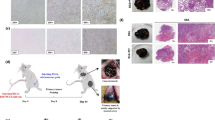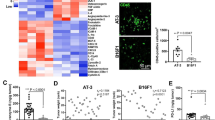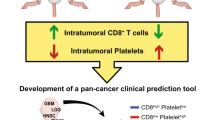Abstract
Progression from a primary tumor to distant metastases requires extensive interactions between tumor cells and their microenvironment. The primary tumor is not only the source of metastatic cells but also can also modulate host responses to these cells, leading to an enhancement or inhibition of metastasis. Tumor-mediated stimulation of bone marrow can result in pre-metastatic niche formation and increased metastasis. However, a primary tumor can also inhibit metastasis through concomitant tumor resistance—inhibition of metastatic growth by existing tumor mass. Here, we report that the presence of a B16F10 primary tumor significantly restricted numbers and sizes of experimental lung metastases through reduction of circulating platelets and reduced formation of metastatic tumor cell-associated thrombi. Tumor-bearing mice displayed splenomegaly, correlated with primary tumor size and platelet count. Reduction in platelet numbers in tumor-bearing animals was responsible for metastatic inhibition, as restoration of platelet numbers using isolated platelets re-established both tumor cell-associated thrombus formation and experimental metastasis. Consumption of platelets due to a B16F10 primary tumor is a form of concomitant tumor resistance and demonstrates the systemic impact of a growing tumor. Understanding the interplay between primary tumors and metastases is essential, as clarification of concomitant tumor resistance mechanisms may allow inhibition of metastatic growth following tumor resection.
Key messages
-
Mice with a primary B16F10 tumor had reduced metastasis vs. mice without a primary tumor.
-
Tumor-bearing mice had splenomegaly and fewer platelets and tumor-associated thrombi.
-
Restoring platelets restored tumor-associated thrombi and increased metastasis.
-
This work shows the impact that a primary tumor can have on systemic metastasis.
-
Understanding these interactions may lead to improved ways to inhibit metastasis.






Similar content being viewed by others
References
Chambers AF, Groom AC, MacDonald IC (2002) Dissemination and growth of cancer cells in metastatic sites. Nat Rev Cancer 2(8):563–572
Labelle M, Hynes RO (2012) The initial hours of metastasis: the importance of cooperative host-tumor cell interactions during hematogenous dissemination. Cancer Discov 2(12):1091–1099
Lorusso G, Ruegg C (2008) The tumor microenvironment and its contribution to tumor evolution toward metastasis. Histochem Cell Biol 130(6):1091–1103
Clark WH Jr, Elder DE, Guerry D, Braitman LE, Trock BJ, Schultz D, Synnestvedt M, Halpern AC (1989) Model predicting survival in stage I melanoma based on tumor progression. J Natl Cancer Inst 81(24):1893–1904
Demicheli R, Retsky MW, Hrushesky WJ, Baum M, Gukas ID (2008) The effects of surgery on tumor growth: a century of investigations. Ann Oncol 19(11):1821–1828
Prehn RT (1991) The inhibition of tumor growth by tumor mass. Cancer Res 51(1):2–4
Gorelik E (1983) Concomitant tumor immunity and the resistance to a second tumor challenge. Adv Cancer Res 39:71–120
Chiarella P, Bruzzo J, Meiss RP, Ruggiero RA (2012) Concomitant tumor resistance. Cancer Lett 324(2):133–141
Galmarini CM, Tredan O, Galmarini FC (2014) Concomitant resistance and early-breast cancer: should we change treatment strategies? Cancer Metastasis Rev 33(1):271–283
O’Reilly MS, Holmgren L, Shing Y, Chen C, Rosenthal RA, Moses M, Lane WS, Cao Y, Sage EH, Folkman J (1994) Angiostatin: a novel angiogenesis inhibitor that mediates the suppression of metastases by a Lewis lung carcinoma. Cell 79(2):315–328
Holmgren L, O’Reilly MS, Folkman J (1995) Dormancy of micrometastases: balanced proliferation and apoptosis in the presence of angiogenesis suppression. Nat Med 1(2):149–153
Folkman J (1995) Angiogenesis inhibitors generated by tumors. Mol Med 1(2):120–122
O’Reilly MS, Holmgren L, Chen C, Folkman J (1996) Angiostatin induces and sustains dormancy of human primary tumors in mice. Nat Med 2(6):689–692
Franco M, Bustuoabad OD, Di Gianni PD, Meiss RP, Vanzulli S, Buggiano V, Pasqualini CD, Ruggiero RA (2000) Two different types of concomitant resistance induced by murine tumors: morphological aspects and intrinsic mechanisms. Oncol Rep 7(5):1053–1063
Turk MJ, Guevara-Patino JA, Rizzuto GA, Engelhorn ME, Sakaguchi S, Houghton AN (2004) Concomitant tumor immunity to a poorly immunogenic melanoma is prevented by regulatory T cells. J Exp Med 200(6):771–782
Falanga A, Panova-Noeva M, Russo L (2009) Procoagulant mechanisms in tumour cells. Best Pract Res Clin Haematol 22(1):49–60
Kirstein JM, Graham KC, Mackenzie LT, Johnston DE, Martin LJ, Tuck AB, MacDonald IC, Chambers AF (2009) Effect of anti-fibrinolytic therapy on experimental melanoma metastasis. Clin Exp Metastasis 26(2):121–131
Im JH, Fu W, Wang H, Bhatia SK, Hammer DA, Kowalska MA, Muschel RJ (2004) Coagulation facilitates tumor cell spreading in the pulmonary vasculature during early metastatic colony formation. Cancer Res 64(23):8613–8619
Palumbo JS, Talmage KE, Massari JV, La Jeunesse CM, Flick MJ, Kombrinck KW, Jirouskova M, Degen JL (2005) Platelets and fibrin(ogen) increase metastatic potential by impeding natural killer cell-mediated elimination of tumor cells. Blood 105(1):178–185
Esumi N, Fan D, Fidler IJ (1991) Inhibition of murine melanoma experimental metastasis by recombinant desulfatohirudin, a highly specific thrombin inhibitor. Cancer Res 51(17):4549–4556
Palumbo JS, Kombrinck KW, Drew AF, Grimes TS, Kiser JH, Degen JL, Bugge TH (2000) Fibrinogen is an important determinant of the metastatic potential of circulating tumor cells. Blood 96(10):3302–3309
Palumbo JS, Potter JM, Kaplan LS, Talmage K, Jackson DG, Degen JL (2002) Spontaneous hematogenous and lymphatic metastasis, but not primary tumor growth or angiogenesis, is diminished in fibrinogen-deficient mice. Cancer Res 62(23):6966–6972
Palumbo JS, Talmage KE, Liu H, La Jeunesse CM, Witte DP, Degen JL (2003) Plasminogen supports tumor growth through a fibrinogen-dependent mechanism linked to vascular patency. Blood 102(8):2819–2827
Palumbo JS, Talmage KE, Massari JV, La Jeunesse CM, Flick MJ, Kombrinck KW, Hu Z, Barney KA, Degen JL (2007) Tumor cell-associated tissue factor and circulating hemostatic factors cooperate to increase metastatic potential through natural killer cell-dependent and-independent mechanisms. Blood 110(1):133–141
Palumbo JS, Barney KA, Blevins EA, Shaw MA, Mishra A, Flick MJ, Kombrinck KW, Talmage KE, Souri M, Ichinose A et al (2008) Factor XIII transglutaminase supports hematogenous tumor cell metastasis through a mechanism dependent on natural killer cell function. J Thromb Haemost 6(5):812–819
Kirszberg C, Lima LG, Da Silva de Oliveira A, Pickering W, Gray E, Barrowcliffe TW, Rumjanek VM, Monteiro RQ (2009) Simultaneous tissue factor expression and phosphatidylserine exposure account for the highly procoagulant pattern of melanoma cell lines. Melanoma Res 19(5):301–308
Gay LJ, Felding-Habermann B (2011) Contribution of platelets to tumour metastasis. Nat Rev Cancer 11(2):123–134
Holmes CE, Levis JE, Ornstein DL (2009) Activated platelets enhance ovarian cancer cell invasion in a cellular model of metastasis. Clin Exp Metastasis 26(7):653–661
Orellana R, Kato S, Erices R, Bravo ML, Gonzalez P, Oliva B, Cubillos S, Valdivia A, Ibanez C, Branes J et al (2015) Platelets enhance tissue factor protein and metastasis initiating cell markers, and act as chemoattractants increasing the migration of ovarian cancer cells. BMC Cancer 15:290
Schmitt A, Guichard J, Masse JM, Debili N, Cramer EM (2001) Of mice and men: comparison of the ultrastructure of megakaryocytes and platelets. Exp Hematol 29(11):1295–1302
Musaji A, Vanhoorelbeke K, Deckmyn H, Coutelier JP (2004) New model of transient strain-dependent autoimmune thrombocytopenia in mice immunized with rat platelets. Exp Hematol 32(1):87–94
Schneider CA, Rasband WS, Eliceiri KW (2012) NIH Image to ImageJ: 25 years of image analysis. Nat Methods 9(7):671–675
Everds NE (2007) Hematology of the laboratory mouse. In: Fox JG, Davisson MT, Quimby FW, Barthold SW, Newcomer CE, Smith AL (eds) The mouse in biomedical research, vol 3, 2nd edn. Elsevier, Inc., Burlington, pp 133–170
Kaplan RN, Riba RD, Zacharoulis S, Bramley AH, Vincent L, Costa C, MacDonald DD, Jin DK, Shido K, Kerns SA et al (2005) VEGFR1-positive haematopoietic bone marrow progenitors initiate the pre-metastatic niche. Nature 438(7069):820–827
Franco M, Bustuoabad OD, di Gianni PD, Goldman A, Pasqualini CD, Ruggiero RA (1996) A serum-mediated mechanism for concomitant resistance shared by immunogenic and non-immunogenic murine tumours. Br J Cancer 74(2):178–186
Ruggiero RA, Bustuoabad OD, Bonfil RD, Meiss RP, Pasqualini CD (1985) “Concomitant immunity” in murine tumours of non-detectable immunogenicity. Br J Cancer 51(1):37–48
Borsig L (2008) The role of platelet activation in tumor metastasis. Expert Rev Anticancer Ther 8(8):1247–1255
Green DL, Karpatkin S (2009) Effect of cancer on platelets. Cancer Treat Res 148:17–30
Nash GF, Turner LF, Scully MF, Kakkar AK (2002) Platelets and cancer. Lancet Oncol 3(7):425–430
McCarty OJ, Mousa SA, Bray PF, Konstantopoulos K (2000) Immobilized platelets support human colon carcinoma cell tethering, rolling, and firm adhesion under dynamic flow conditions. Blood 96(5):1789–1797
Niers TM, Bruggemann LW, Klerk CP, Muller FJ, Buckle T, Reitsma PH, Richel DJ, Spek CA, Van Tellingen O, Van Noorden CJ (2009) Differential effects of anticoagulants on tumor development of mouse cancer cell lines B16, K1735 and CT26 in lung. Clin Exp Metastasis 26(3):171–178
Horowitz NA, Blevins EA, Miller WM, Perry AR, Talmage KE, Mullins ES, Flick MJ, Queiroz KC, Shi K, Spek CA et al (2011) Thrombomodulin is a determinant of metastasis through a mechanism linked to the thrombin binding domain but not the lectin-like domain. Blood 118(10):2889–2895
Kimoto M, Ando K, Koike S, Matsumoto T, Jibu T, Moriya H, Kanegasaki S (1993) Significance of platelets in an antimetastatic activity of bacterial lipopolysaccharide. Clin Exp Metastasis 11(3):285–292
Kimura AK, Mehta P, Xiang JH, Lawson D, Dugger D, Kao KJ, Lee-Ambrose L (1987) The lack of correlation between experimental metastatic potential and platelet aggregating activity of B16 melanoma clones viewed in relation to tumor cell heterogeneity. Clin Exp Metastasis 5(2):125–133
Mahalingam M, Ugen KE, Kao KJ, Klein PA (1988) Functional role of platelets in experimental metastasis studied with cloned murine fibrosarcoma cell variants. Cancer Res 48(6):1460–1464
Kirszberg C, Rumjanek VM, Monteiro RQ (2005) Assembly and regulation of prothrombinase complex on B16F10 melanoma cells. Thromb Res 115(1–2):123–129
Kvolik S, Jukic M, Matijevic M, Marjanovic K, Glavas-Obrovac L (2010) An overview of coagulation disorders in cancer patients. Surg Oncol 19(1):e33–e46
Lima LG, Chammas R, Monteiro RQ, Moreira ME, Barcinski MA (2009) Tumor-derived microvesicles modulate the establishment of metastatic melanoma in a phosphatidylserine-dependent manner. Cancer Lett 283(2):168–175
Kakkar AK (2009) Antithrombotic therapy and survival in cancer patients. Best Pract Res Clin Haematol 22(1):147–151
Kakkar AK, Macbeth F (2010) Antithrombotic therapy and survival in patients with malignant disease. Br J Cancer 102(Suppl 1):S24–S29
Franchini M, Mannucci PM (2015) Low-molecular-weight heparins and cancer: focus on antitumoral effect. Ann Med 47(2):116–121
Macbeth F, Noble S, Evans J, Ahmed S, Cohen D, Hood K, Knoyle D, Linnane S, Longo M, Moore B et al (2016) Randomized phase III trial of standard therapy plus low molecular weight heparin in patients with lung cancer: FRAGMATIC trial. J Clin Oncol 34(5):488–494
Acknowledgments
We would like to thank Dr. Ian Welch for his assistance with interpreting murine spleen data. JMK was supported by a National Sciences and Engineering Council of Canada Post-Graduate Research Award. JMK and PMM were supported by traineeships from the Pamela Greenaway Kohlmeier Translational Breast Cancer Research Unit, supported in part by the Breast Cancer Society of Canada. AFC is Canada Research Chair in Oncology supported by the Canada Research Chairs Program.
Author information
Authors and Affiliations
Corresponding author
Ethics declarations
Conflict of interest
The authors declare that they have no conflicts of interest.
Rights and permissions
About this article
Cite this article
Kirstein, J.M., Hague, M.N., McGowan, P.M. et al. Primary melanoma tumor inhibits metastasis through alterations in systemic hemostasis. J Mol Med 94, 899–910 (2016). https://doi.org/10.1007/s00109-016-1415-2
Received:
Revised:
Accepted:
Published:
Issue Date:
DOI: https://doi.org/10.1007/s00109-016-1415-2




